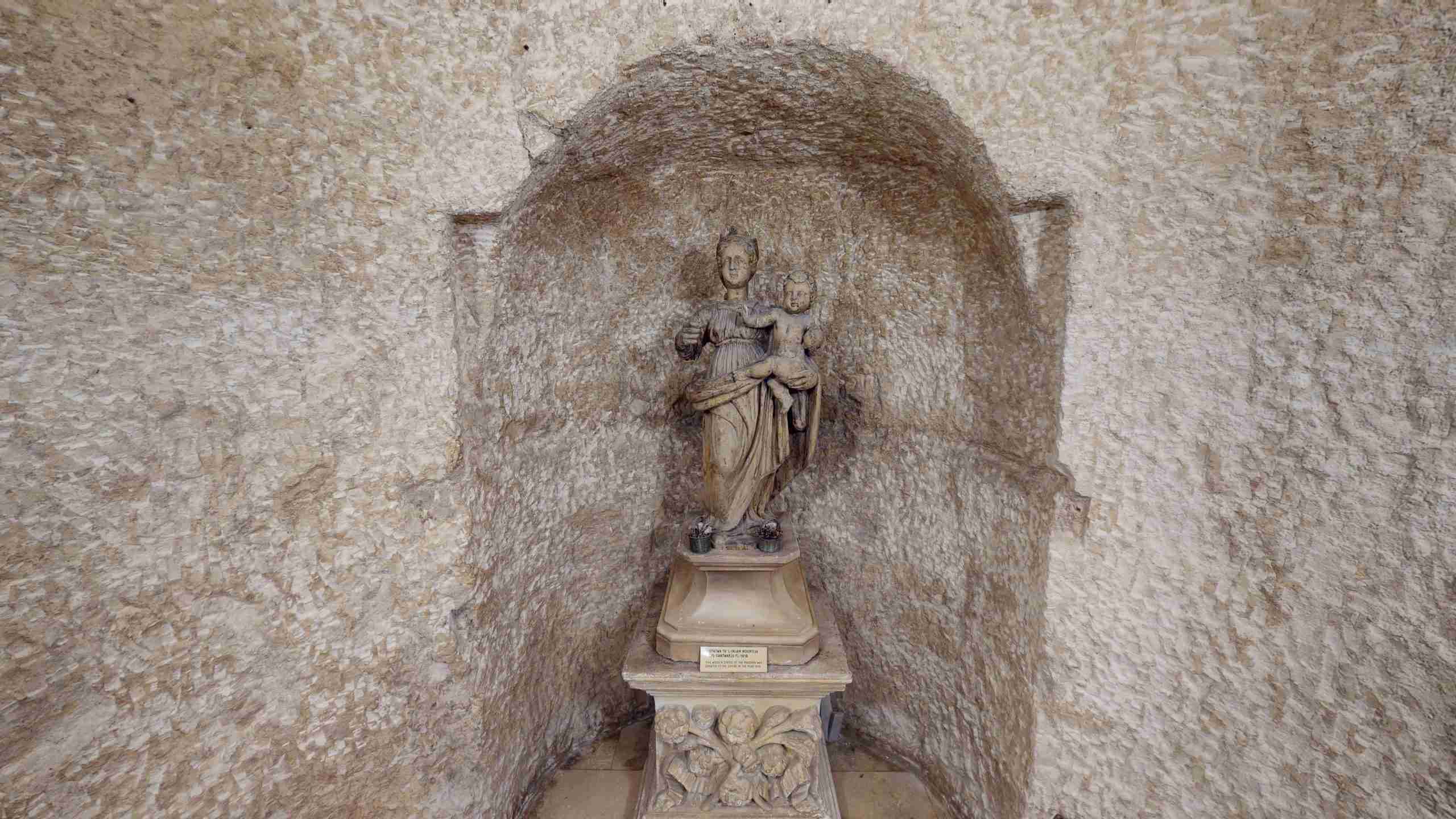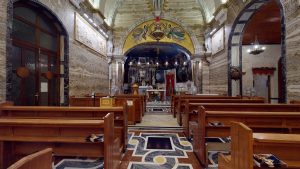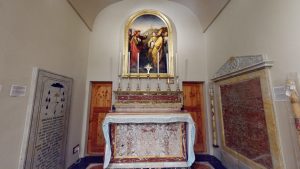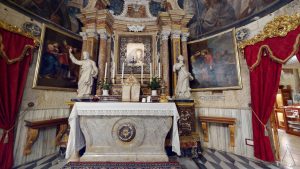
WELCOME!
to
The Sanctuary of Our Lady of Mellieħa

According to a very old tradition the highly venerated sanctuary of the Nativity of Our Lady of Mellieha was blessed by St. Paul the Apostle. The same tradition would have it that the icon of our Lady painted on the bare rock is the work of St. Luke the Evangelist; a theory supported by Mons. Pirri (1630), Ġan Franġisk Abela, Giacomo Bosio, Count G.A. Ciantar and Mons. O. Bres. On the contrary, Mario Buhagiar wrote that it is “Byzantinesque in inspiration but Sicilian or South Italian in execution, (and) datable to the late thirteenth or early fourteenth centuries.” (The Iconography of the Maltese Islands)
 That it has enjoyed the great devotion of the Maltese people is evidenced by the large number of ex-votos and other offerings.
That it has enjoyed the great devotion of the Maltese people is evidenced by the large number of ex-votos and other offerings.
A number of bishops appear in the painting on the sanctuary ceiling. It is believed that they represent seven bishops who according to a pious legend visited the cave sanctuary while on their way to a Council at Milevo, near Carthage, in the year 416. Seven crosses painted on the walls are claimed, on no evidence, to indicate that these seven bishops consecrated the cave. Similarly unfounded is the story that Augustinian friars looked after the sanctuary in 420 AD.
Important visitors are said to have included King Ferdinand IV (1373), King Martin (1408), King Alfonso (1432), Viceroy Lupo Ximénez (1468), Ferdinand d’Acuña (1490), and much later Bishop Lavigerie, Nicola Speciale, and St. Benedict Joseph Labre, who was visiting the Marian sanctuaries of Europe.
In 1436, Mellieha was one of the tenparishes mentioned in the financial report presented to Bishop Senatore de Mello. It extended as far as Mosta. However, as Mellieha was exposed too much to the frequent attacks of Turks and pirates, in 1551 it was annexed to the parish of Naxxar. In 1614 the invaders sacked the Mellieha sanctuary. Bishop Balaguer, writing some forty years later, recounted how one of the attackers, on recovering from a serious illness which he considered to be a punishment for his part in the raid, sent a votive candle to the sanctuary.
tenparishes mentioned in the financial report presented to Bishop Senatore de Mello. It extended as far as Mosta. However, as Mellieha was exposed too much to the frequent attacks of Turks and pirates, in 1551 it was annexed to the parish of Naxxar. In 1614 the invaders sacked the Mellieha sanctuary. Bishop Balaguer, writing some forty years later, recounted how one of the attackers, on recovering from a serious illness which he considered to be a punishment for his part in the raid, sent a votive candle to the sanctuary.
During the Great Siege, Don García de Toledo who landed his relieving force at Mellieha Bay visited the sanctuary on the 7th September. Since that day it came to be known as the church of the Nativity of Our Lady, popularly known as “il-Vitorja”.
Ten years later, when Mgr. Dusina visited the sanctuary, he found it without a rector, without an income, and quite bare. It was still rectorless in 1587 when Bishop Gargallo visited it, and so it remained till the year 1603 when he appointed Dun Bernard Cassar to the post.
 The year 1614 saw the Turkish attack mentioned above, after which Grand Master Alof de Wignacourt began to visit the sanctuary regularly on Saturdays, The Brotherhood of the Holy Rosary was formed in 1669. In 1690 Mario de Vasi, of Syracuse, enlarged and embellished the church, placed a statue in the lower crypt, built a house for the rector and rest rooms for pilgrims. The church was enlarged further and consecrated by bishop Alpheran de Bussan on 21st. May 1747
The year 1614 saw the Turkish attack mentioned above, after which Grand Master Alof de Wignacourt began to visit the sanctuary regularly on Saturdays, The Brotherhood of the Holy Rosary was formed in 1669. In 1690 Mario de Vasi, of Syracuse, enlarged and embellished the church, placed a statue in the lower crypt, built a house for the rector and rest rooms for pilgrims. The church was enlarged further and consecrated by bishop Alpheran de Bussan on 21st. May 1747
In 1834 Mellieha became a vice-parish, and in 1844 Bishop Caruana again raised it to the status of parish, following the grant of a bull by Pope Gregory XVI. The first parish priest was Dun Pawl le Brun. The building of the new parish church started in 1883. By decree of Pope Leo XIII the miraculous icon was crowned on the 24th September, 1899, by Bishop Pietru Pace, assisted by the Bishop of Gozo, Mgr. G.M. Camilleri.
In recent years the sanctuary has been extensively decorated, the walls being covered with marble. There are now five altars, and paintings of Our Lady of Carmel, St. Andrew and St. Paul. Canon Dun Vicenz Grech Delicata donated to the sanctuary the relics of St. Vincent, martyr, brought from the Cemetery of Priscilla in Rome on the 21st April, 1920. Popes John XXIII and Paul VI have honoured the sanctuary. Pope John Paul Il prayed in the sanctuary on the 26th May. 1990.
Many have been the graces obtained through the intercession of Our Lady, those of rain after periods of severe drought being particularly remembered. A national pilgrimage which took place in 1718 is commemorated by the arch erected outside the church. Another national pilgrimage, this time during a cholera epidemic, was in 1888 led by the Apostolic Administrator, Mgr. A.M. Buhagiar.
Credit: 100 Wayside Chapels of Malta by Kilin, published by Midsea Books (All rights reserved)
The Marian Church
Catholic Marian churches are places of worship where the Blessed Virgin Mary is revered. Today, these churches can be  found on every continent, including Antarctica. They were constructed throughout the Catholic Church’s history. The development of Catholic Mariology is traced via the history of Marian church construction.
found on every continent, including Antarctica. They were constructed throughout the Catholic Church’s history. The development of Catholic Mariology is traced via the history of Marian church construction.
The building and dedication of Marian churches is frequently a good indicator of the mariological fads during a time, such a papal reign. For instance, Pope Pius XII rededicated Saint James the Great Church in Montreal in 1955 under the new name Mary, Queen of the World, Cathedral as a result of his reputation as “the most Marian pope.”
In his 1954 encyclical Ad Caeli Reginam, Pope Pius XII bestowed that title on the Virgin Mary. This encyclical on the Queen of Heaven is an illustration of how churches and Marian art interact to strengthen the impact of Marian devotions.
Local legends date the founding of the Sanctuary of Our Lady of Mellieħa, which was once a natural cave that was dedicated as a church, to either antiquity or the Middle Ages. The church’s altarpiece is a Byzantine-style fresco that is supposed to be miraculous and dates to the late 12th or early 13th century.
By the beginning of the 15th century, it had become a parish church, and even after being incorporated into another parish, the church continued to be a significant destination for pilgrims. Parts of the original church’s natural cave were incorporated into the current structure, which was built between the late 16th and early 18th centuries in phases.